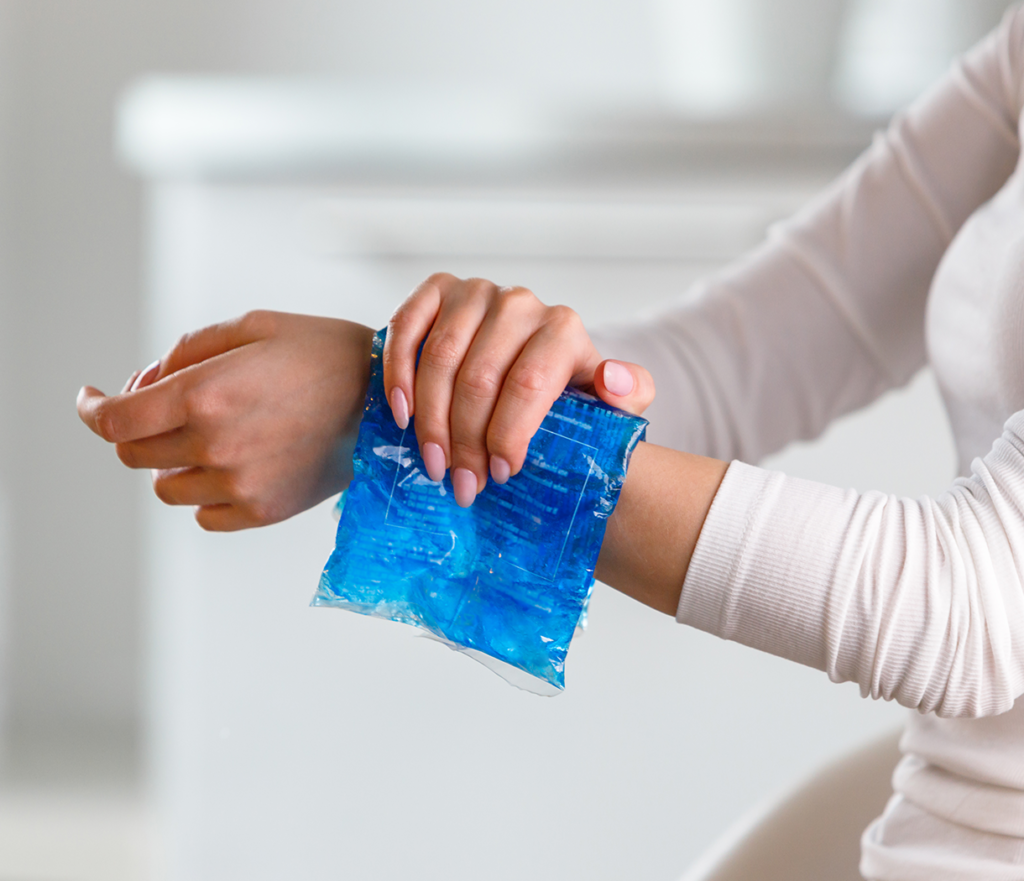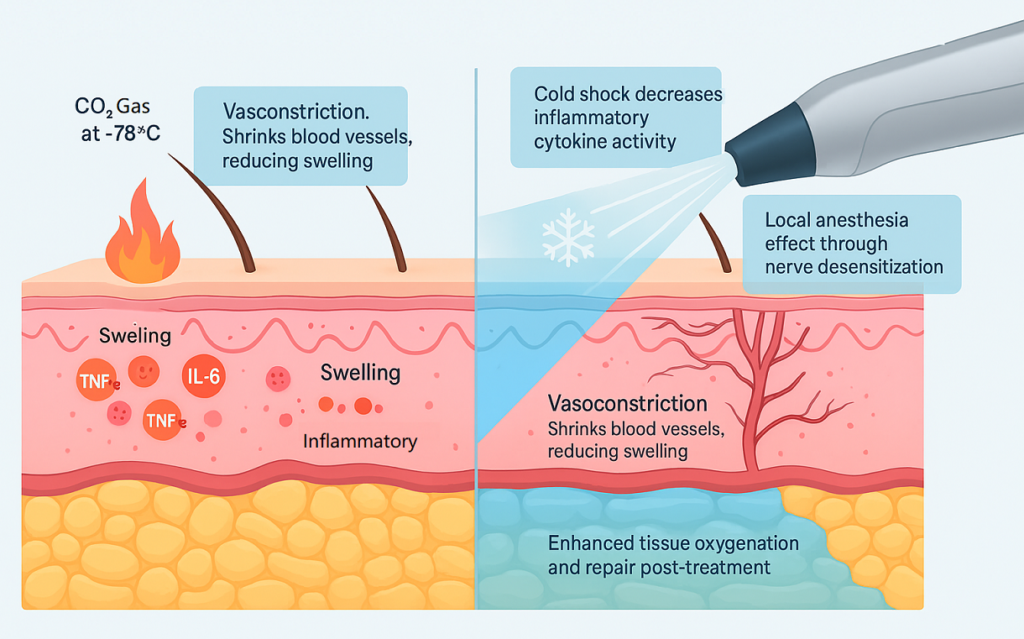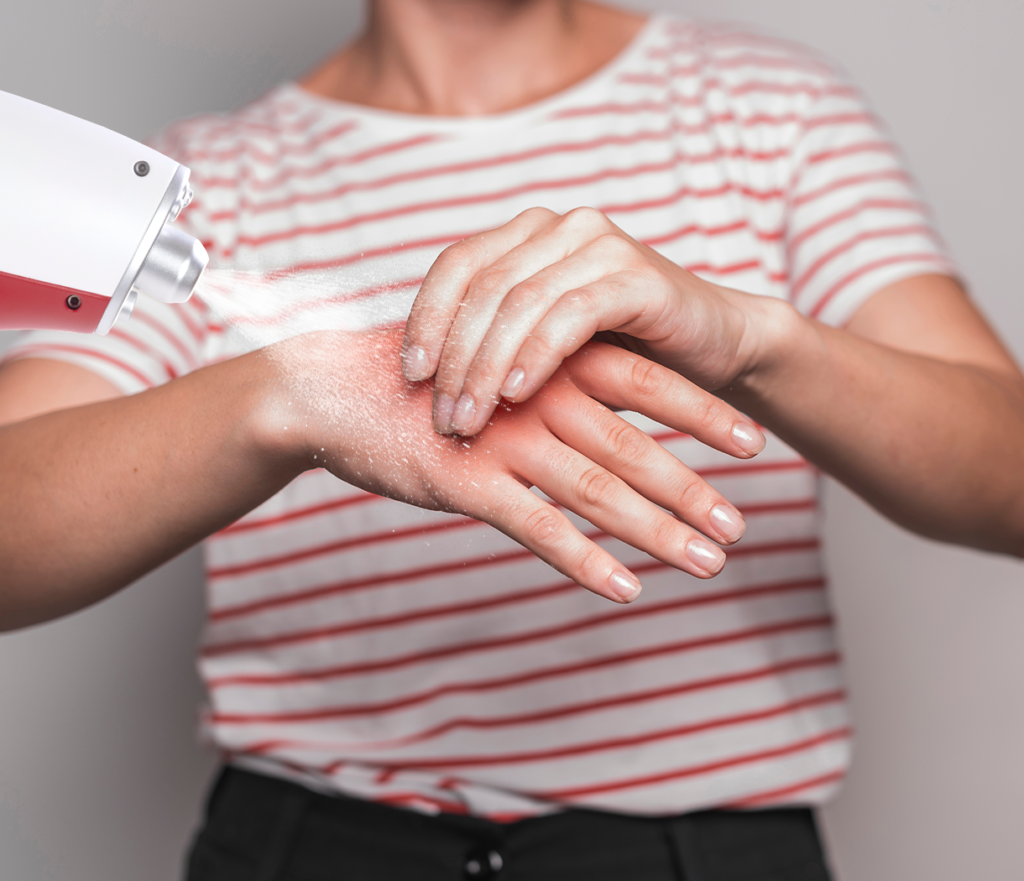Introduction: Turning Down the Heat on Inflammation
In the evolving landscape of modern healthcare, the quest for effective, non-invasive treatments has led practitioners and patients alike to explore innovative therapeutic modalities. Among these emerging solutions, CO₂ cryotherapy stands out as a revolutionary approach to managing inflammation—one of medicine’s most persistent challenges. This comprehensive exploration delves into how this cutting-edge treatment harnesses the power of extreme cold to combat the body’s inflammatory responses.
The Burden of Inflammation in Modern Health
Inflammation represents one of the most fundamental biological processes, serving as both protector and perpetrator in human health. While acute inflammatory responses are essential for healing and immune defense, chronic inflammation has emerged as a silent epidemic underlying numerous pathological conditions. From arthritis affecting millions worldwide to post-surgical complications that delay recovery, inflammatory processes contribute to an estimated 60% of chronic diseases. The economic burden alone exceeds billions annually in healthcare costs, lost productivity, and diminished quality of life for patients across all demographics.
Rise of Non-Pharmacological Treatments
As healthcare systems grapple with increasing antibiotic resistance, opioid dependency concerns, and adverse drug reactions, the medical community has intensified its focus on non-pharmacological interventions. These treatments offer compelling advantages: reduced systemic side effects, enhanced patient safety profiles, and the potential for long-term therapeutic benefits without chemical dependency. Physical therapy modalities, including cryotherapy, have gained significant traction as evidence-based alternatives. Recent clinical studies demonstrate that non-pharmacological approaches can be as effective as traditional medications while minimizing risks associated with polypharmacy and drug interactions.
CO₂ Cryotherapy: A Chilling Innovation Worth Exploring
CO₂ cryotherapy represents the next evolutionary step in cold therapy applications, utilizing pressurized carbon dioxide to achieve therapeutic temperatures as low as -78°C. Unlike traditional cryotherapy methods, this innovative approach delivers precise, controlled cooling that penetrates deeper into tissues while maintaining safety and patient comfort. The technology has garnered attention from sports medicine professionals, rehabilitation specialists, and pain management clinicians who recognize its potential to revolutionize inflammatory condition treatment. With application times as brief as 10-15 seconds, CO₂ cryotherapy offers convenience and efficacy that traditional ice therapy cannot match.
Understanding CO₂ Cryotherapy
The scientific foundation of CO₂ cryotherapy rests upon decades of cryogenic research and therapeutic cold application principles. This advanced treatment modality represents a significant leap forward from conventional cooling methods, offering unprecedented precision and therapeutic potential. Understanding its mechanisms requires examining both the physics of carbon dioxide phase transitions and the biological responses to controlled hypothermic exposure.
What Is CO₂ Cryotherapy?
CO₂ cryotherapy involves the therapeutic application of pressurized carbon dioxide gas to achieve localized tissue cooling for medical purposes. The treatment utilizes specialized delivery systems that convert liquid CO₂ into a controlled gas stream, creating temperatures of -78°C upon tissue contact. This precise cooling mechanism triggers a cascade of physiological responses including vasoconstriction, metabolic rate reduction, and neural pathway modulation. The therapy’s non-invasive nature allows for targeted treatment of specific anatomical regions without systemic effects, making it suitable for various inflammatory conditions ranging from acute sports injuries to chronic pain syndromes.
How CO₂ Cryotherapy Works
The therapeutic mechanism begins when pressurized CO₂ undergoes rapid expansion through specialized nozzles, creating an endothermic reaction that dramatically reduces temperature. Upon contact with skin and underlying tissues, this extreme cold initiates immediate vasoconstriction, reducing blood flow to the treatment area by up to 80% within seconds. Simultaneously, the cold stimulus activates thermoreceptors and nociceptors, triggering counter-irritant effects that modulate pain perception through the gate control theory. The brief 10-15 second application creates controlled local hypothermia that persists for several minutes, allowing inflammatory mediators to be flushed from tissues during the subsequent vasodilation phase.
CO₂ vs. Traditional Ice Therapy: What’s the Difference?
Traditional ice therapy, while effective, presents significant limitations including temperature inconsistency, prolonged application requirements, and potential tissue damage from excessive cold exposure. CO₂ cryotherapy overcomes these challenges through precise temperature control, rapid application protocols, and enhanced therapeutic penetration. While ice therapy typically requires 15-20 minutes to achieve therapeutic effects, CO₂ treatment accomplishes similar results in 10-15 seconds. The controlled nature of CO₂ delivery eliminates risks of frostbite or thermal burns associated with direct ice application, while the dry cold prevents moisture-related complications that can compromise treatment efficacy and patient comfort.

Inflammation: A Closer Look
Inflammation constitutes one of the body’s most sophisticated defense mechanisms, orchestrating complex cellular and molecular responses to tissue injury, infection, or irritation. This fundamental biological process involves intricate interactions between immune cells, chemical mediators, and vascular components. Understanding inflammation’s multifaceted nature provides essential context for appreciating how therapeutic interventions like CO₂ cryotherapy can effectively modulate these responses.
What Is Inflammation and Why Does It Hurt?
Inflammation represents the body’s coordinated response to harmful stimuli, characterized by the classic signs of rubor (redness), tumor (swelling), calor (heat), dolor (pain), and functio laesa (loss of function). At the cellular level, this process involves vasodilation, increased vascular permeability, and recruitment of immune cells including neutrophils, macrophages, and lymphocytes. Pain arises from the release of inflammatory mediators such as prostaglandins, leukotrienes, and cytokines that sensitize nociceptors and lower pain thresholds. Additionally, tissue swelling creates mechanical pressure on nerve endings, while the accumulation of metabolic byproducts further contributes to discomfort and functional impairment.
Acute vs. Chronic Inflammation
Acute inflammation serves as a protective mechanism designed to eliminate harmful agents and initiate tissue repair, typically resolving within days to weeks. This process involves rapid onset, intense symptoms, and eventual resolution through specialized pro-resolving mediators. Conversely, chronic inflammation represents a persistent, low-grade inflammatory state that can persist for months or years, characterized by ongoing tissue damage and impaired healing responses. Chronic inflammation involves different cellular populations, including activated macrophages and fibroblasts, leading to tissue remodeling and potential organ dysfunction. This prolonged inflammatory state underlies numerous pathological conditions including cardiovascular disease, diabetes, and neurodegenerative disorders.
Common Conditions Marked by Inflammation
Inflammatory conditions encompass a broad spectrum of disorders affecting virtually every organ system. Musculoskeletal conditions such as rheumatoid arthritis, osteoarthritis, and fibromyalgia involve chronic inflammatory processes that compromise joint function and cause persistent pain. Sports-related injuries including tendinitis, bursitis, and muscle strains represent acute inflammatory responses to tissue trauma. Post-surgical inflammation, while necessary for healing, can become problematic when excessive, leading to prolonged recovery times and complications. Additionally, autoimmune conditions like lupus and multiple sclerosis involve dysregulated inflammatory responses that attack healthy tissues, requiring sophisticated management strategies to control symptoms and prevent progression.
The Anti-Inflammatory Power of CO₂ Cryotherapy
The therapeutic efficacy of CO₂ cryotherapy stems from its ability to modulate multiple inflammatory pathways simultaneously. This multifaceted approach addresses inflammation at both the vascular and cellular levels, creating a comprehensive therapeutic response that exceeds traditional single-mechanism treatments. Recent research has illuminated the complex interplay between cold-induced physiological changes and inflammatory mediator regulation, providing scientific validation for clinical observations.
Vasoconstriction: Shrinking Swelling at the Source
CO₂ cryotherapy induces immediate and pronounced vasoconstriction through cold-mediated activation of α-adrenergic receptors in vascular smooth muscle. This response reduces local blood flow by 70-80% within seconds of application, effectively limiting the delivery of inflammatory cells and mediators to the treatment site. The controlled vasoconstriction also reduces capillary hydrostatic pressure, minimizing fluid extravasation and tissue edema formation. Unlike pharmacological vasoconstrictors, cold-induced vasoconstriction is reversible and localized, preventing systemic cardiovascular effects while maintaining the therapeutic benefit. The subsequent vasodilation phase, occurring 10-15 minutes post-treatment, enhances metabolic waste removal and promotes healing through improved tissue perfusion.
How CO₂ Cryotherapy Lowers Inflammatory Cytokine Activity
Cryotherapy exposure significantly reduces levels of pro-inflammatory cytokines including interleukin-1β (IL-1β) while increasing anti-inflammatory mediators such as interleukin-10 (IL-10). The cold stimulus inhibits nuclear factor-κB (NF-κB) activation, a key transcription factor responsible for inflammatory gene expression. Additionally, CO₂ cryotherapy reduces the activity of cyclooxygenase-2 (COX-2) and lipoxygenase enzymes, limiting prostaglandin and leukotriene synthesis. The treatment also modulates complement cascade activation and reduces C-reactive protein levels, indicating systemic anti-inflammatory effects. These molecular changes translate into clinically significant reductions in pain, swelling, and functional impairment across various inflammatory conditions.
Local Hypothermia and Nerve Desensitization for Pain Control
The rapid temperature reduction achieved through CO₂ cryotherapy creates localized hypothermia that significantly alters nerve conduction velocities and pain transmission. Cold temperatures below 10°C reduce nerve conduction velocity by 1.5-2.4 m/s per degree Celsius decrease, effectively blocking pain signal transmission to the central nervous system. The treatment activates large-diameter Aβ fibers while inhibiting smaller C-fibers responsible for nociceptive transmission, creating analgesic effects through the gate control mechanism. Additionally, cold exposure triggers the release of endogenous opioids including β-endorphins and enkephalins, providing natural pain relief that can persist for hours after treatment completion.
Enhanced Oxygenation and Blood Flow Post-Application
Following the initial vasoconstriction phase, CO₂ cryotherapy induces a robust vasodilation response that significantly enhances tissue perfusion and oxygenation. This reactive hyperemia increases blood flow by 200-300% above baseline levels, facilitating enhanced nutrient delivery and metabolic waste removal. The improved circulation promotes cellular metabolism and tissue repair processes while maintaining the anti-inflammatory benefits achieved during the cooling phase. Micro-circulatory improvements persist for 2-4 hours post-treatment, creating an optimal environment for tissue healing and regeneration. This biphasic vascular response distinguishes CO₂ cryotherapy from traditional cooling methods that may impair circulation for extended periods.

Key Benefits of CO₂ Cryotherapy for Inflammation
The clinical advantages of CO₂ cryotherapy extend beyond simple cooling effects, encompassing a comprehensive therapeutic profile that addresses multiple aspects of inflammatory conditions. These benefits have been documented across diverse patient populations and clinical settings, establishing CO₂ cryotherapy as a valuable addition to modern therapeutic protocols. The treatment’s unique characteristics offer distinct advantages over conventional anti-inflammatory interventions.
Rapid Pain and Swelling Relief Without Medication
CO₂ cryotherapy provides immediate analgesic effects within minutes of application, achieving pain reduction comparable to pharmacological interventions without associated side effects. The treatment reduces visual analog scale (VAS) pain scores by 40-60% in most patients, with effects lasting 4-8 hours post-treatment. Swelling reduction occurs through multiple mechanisms including vasoconstriction, reduced capillary permeability, and enhanced lymphatic drainage. The absence of systemic absorption eliminates concerns about drug interactions, contraindications, or adverse reactions commonly associated with anti-inflammatory medications. This makes the treatment suitable for patients with medication allergies, gastrointestinal sensitivities, or those seeking non-pharmacological alternatives.
Accelerated Healing for Sports Injuries and Post-Surgery
Athletic populations benefit significantly from CO₂ cryotherapy’s ability to expedite recovery from acute injuries and intense training sessions. The treatment reduces secondary tissue damage through controlled inflammation modulation while maintaining the beneficial aspects of the healing response. Clinical studies in sports medicine confirm reduced recovery times and improved functional outcomes following cryotherapy interventions. Post-surgical patients experience decreased analgesic requirements, reduced complications, and faster return to normal activities. The treatment’s precision allows targeted application to specific surgical sites without compromising overall healing processes, making it valuable for orthopedic, plastic, and general surgical procedures.
A Non-Invasive Option for Chronic Inflammatory Conditions
Patients with chronic inflammatory conditions such as rheumatoid arthritis, fibromyalgia, and chronic regional pain syndrome benefit from CO₂ cryotherapy’s gentle yet effective approach. Research demonstrates significant pain reduction and improved disease activity scores in rheumatoid arthritis patients following chronic cryotherapy treatment. The treatment can be repeated safely without cumulative toxicity or tolerance development, making it suitable for long-term management protocols. Integration with existing therapeutic regimens enhances overall treatment efficacy while potentially reducing medication dependence. The non-invasive nature eliminates infection risks, recovery periods, and complications associated with more aggressive interventions.
Enhancing Mobility and Function Safely and Effectively
Functional improvement represents a primary therapeutic goal in inflammatory condition management, and CO₂ cryotherapy contributes significantly to mobility restoration. The treatment reduces joint stiffness, muscle spasm, and movement-related pain, enabling increased range of motion and improved functional capacity. Patients report enhanced ability to perform activities of daily living, participate in exercise programs, and maintain employment responsibilities. The safety profile allows frequent applications without concerns about tissue damage or systemic effects, supporting aggressive rehabilitation protocols. Combined with physical therapy and occupational therapy interventions, CO₂ cryotherapy accelerates functional recovery and improves long-term outcomes.
Clinical Evidence and Expert Opinions
The scientific foundation supporting CO₂ cryotherapy continues to expand as researchers investigate its mechanisms and clinical applications. Current evidence encompasses both controlled clinical trials and observational studies across diverse patient populations and inflammatory conditions. This growing body of research provides healthcare providers with evidence-based rationale for incorporating CO₂ cryotherapy into treatment protocols.
What Studies Say About CO₂ Cryotherapy and Inflammatory Markers
Recent meta-analyses demonstrate that cryotherapy significantly reduces systemic inflammation markers in both healthy individuals and clinical populations. Studies measuring C-reactive protein, erythrocyte sedimentation rate, and cytokine profiles consistently show improvement following cryotherapy interventions. Biomarker studies reveal sustained anti-inflammatory effects lasting 24-48 hours post-treatment, indicating prolonged therapeutic benefit beyond immediate symptom relief. Research comparing CO₂ cryotherapy to traditional cooling methods shows superior outcomes in inflammatory marker reduction and patient-reported outcomes. These findings support the integration of CO₂ cryotherapy into evidence-based inflammatory condition management protocols.
Healthcare Provider Testimonials
Clinicians across multiple specialties report positive experiences with CO₂ cryotherapy integration into their practice protocols. Physical therapists note enhanced patient compliance due to brief treatment duration and immediate symptom relief. Pain management specialists appreciate the treatment’s ability to reduce opioid requirements while maintaining therapeutic efficacy. Sports medicine physicians report faster return-to-play times and reduced injury recurrence rates among athletes receiving CO₂ cryotherapy. Rheumatologists observe improved quality of life scores and reduced disease activity indices in chronic inflammatory condition patients. These clinical observations support the growing adoption of CO₂ cryotherapy across healthcare settings.
Application in Sports Medicine and Rehabilitation Settings
Sports medicine and rehabilitation facilities have emerged as primary adoption sites for CO₂ cryotherapy due to its alignment with performance optimization and injury prevention goals. Professional sports teams utilize the treatment for post-exercise recovery, pre-competition preparation, and acute injury management. Rehabilitation centers integrate CO₂ cryotherapy into comprehensive treatment protocols for post-surgical patients and chronic pain conditions. The treatment’s rapid application and immediate effects make it suitable for high-volume clinical settings. Documentation of improved patient outcomes and satisfaction scores supports continued expansion of CO₂ cryotherapy utilization in these specialized environments.
Real-World Outcomes from Chronic Inflammatory Patients
Patient-reported outcomes from chronic inflammatory condition management reveal significant improvements in quality of life measures following CO₂ cryotherapy implementation. Fibromyalgia patients report reduced pain intensity, improved sleep quality, and enhanced functional capacity. Arthritis patients demonstrate increased joint mobility, reduced morning stiffness, and decreased analgesic consumption. Clinical studies show significant improvements in disability scores and serum inflammatory markers in chronic low back pain patients following whole-body cryotherapy treatment. Long-term follow-up data indicates sustained benefits with regular treatment protocols, supporting the therapy’s role in chronic condition management.
Who Can Benefit from CO₂ Cryotherapy?
The versatility of CO₂ cryotherapy makes it suitable for diverse patient populations across various clinical presentations. Understanding appropriate candidates ensures optimal treatment outcomes while maintaining safety standards. This comprehensive overview examines specific populations that derive maximum benefit from CO₂ cryotherapy interventions.
Athletes Managing Overuse Injuries or Muscle Fatigue
Competitive and recreational athletes face constant challenges from training-induced inflammation, overuse injuries, and post-exercise muscle soreness. CO₂ cryotherapy provides rapid recovery enhancement, allowing athletes to maintain training intensity while minimizing injury risk. The treatment effectively manages conditions such as runner’s knee, tennis elbow, and shin splints without performance-compromising side effects. Professional athletes report improved training consistency and reduced seasonal injury rates when CO₂ cryotherapy is integrated into their recovery protocols. The treatment’s brief application time fits seamlessly into busy training schedules, making it practical for competitive environments.
Patients with Joint or Tendon Disorders
Inflammatory joint and tendon conditions significantly benefit from CO₂ cryotherapy’s targeted anti-inflammatory effects. Bursitis patients experience rapid pain relief and improved joint mobility following treatment applications. Tendinopathy conditions including Achilles tendinitis and rotator cuff inflammation show improved healing responses when CO₂ cryotherapy is combined with appropriate exercise protocols. Arthritis patients across all disease subtypes report enhanced functional capacity and reduced analgesic requirements. The treatment’s safety profile makes it suitable for elderly patients and those with multiple comorbidities who may not tolerate pharmacological interventions well.

Post-Surgical Individuals in Orthopedic Recovery
Orthopedic surgery patients benefit significantly from CO₂ cryotherapy’s ability to manage post-operative inflammation and pain while supporting healing processes. Joint replacement patients experience reduced swelling, improved range of motion, and faster rehabilitation progression. Arthroscopic surgery patients report decreased pain levels and earlier return to normal activities. The treatment’s precision allows targeted application to surgical sites without affecting surrounding healthy tissues. Integration with comprehensive rehabilitation programs enhances overall recovery outcomes and patient satisfaction scores.
People with Chronic Pain or Fibromyalgia
Chronic pain conditions, particularly fibromyalgia, present complex management challenges that often benefit from multimodal therapeutic approaches. CO₂ cryotherapy addresses multiple fibromyalgia symptoms including widespread pain, sleep disturbances, and fatigue through its neurological and inflammatory effects. Patients report improved pain threshold, enhanced sleep quality, and increased daily functional capacity. The treatment’s non-pharmacological nature makes it valuable for patients seeking to reduce medication dependence or those experiencing adverse effects from traditional analgesics. Regular treatment schedules maintain therapeutic benefits while improving overall quality of life measures.
Individuals Managing Autoimmune or Neurological Inflammation
Autoimmune conditions involving inflammatory processes benefit from CO₂ cryotherapy’s immunomodulatory effects. Multiple sclerosis patients report reduced spasticity and improved mobility following treatment protocols. Inflammatory bowel disease patients may experience systemic anti-inflammatory benefits that complement their primary treatments. Neurological conditions with inflammatory components show potential for symptom improvement through controlled inflammatory modulation. The treatment’s safety profile makes it suitable for immunocompromised patients who require careful intervention selection. Coordination with rheumatologists and neurologists ensures optimal integration with existing therapeutic regimens.
Office Workers with Postural Pain and Repetitive Strain Injuries
Modern workplace conditions contribute to increasing rates of repetitive strain injuries and postural pain syndromes. CO₂ cryotherapy effectively addresses conditions such as carpal tunnel syndrome, cervical strain, and lower back pain associated with prolonged sitting and computer use. The treatment’s brief application time makes it convenient for busy professionals seeking effective symptom management. Regular preventive treatments can reduce the likelihood of chronic condition development and maintain workplace productivity. Integration with ergonomic improvements and exercise programs provides comprehensive management of occupational musculoskeletal disorders.
Final Thoughts: Cooling Down Inflammation, One Burst at a Time
CO₂ cryotherapy is transforming inflammation management by blending advanced technology with natural physiological responses. It offers rapid, effective relief with a strong safety record, making it a valuable option in modern pain and inflammation treatment protocols. As research advances, its clinical uses and optimized protocols are expected to grow. The rising demand for non-drug therapies, combined with evidence-based care and innovations in therapeutic delivery, supports the adoption of CO₂ cryotherapy across medical fields. Its effectiveness in addressing various conditions showcases its versatility. Looking ahead, further development in treatment techniques and integration with digital health tools will boost its potential. For those seeking a fast, safe, and non-invasive solution, CO₂ cryotherapy delivers both immediate relief and long-term management for inflammatory issues.
FAQs About CO₂ Cryotherapy and Inflammation Relief
A: CO₂ cryotherapy provides targeted, localized treatment using pressurized carbon dioxide at -78°C for 10-15 seconds, while whole-body cryotherapy involves full-body exposure in chambers at -110°C for 2-3 minutes. CO₂ therapy offers precise application to specific problem areas with greater convenience and lower cost.
A: Yes, CO₂ cryotherapy can be safely applied daily due to its brief exposure time and controlled temperature delivery. The treatment doesn’t cause tissue damage when properly administered, making it suitable for regular use in chronic condition management.
A: Most patients experience immediate pain relief within minutes of treatment, with maximum benefits typically occurring within 2-4 hours. Anti-inflammatory effects can persist for 24-48 hours, though individual responses may vary based on condition severity and patient factors.
A: Contraindications include open wounds, severe cardiovascular disease, cold hypersensitivity, and certain neurological conditions. A thorough medical evaluation ensures safe and effective treatment application for each individual patient.



